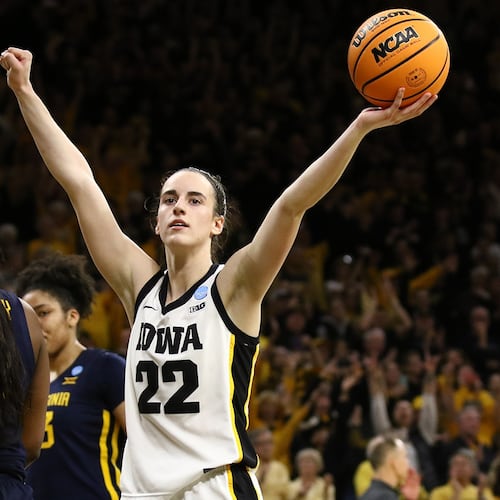The season isn’t a month old, and anybody who has watched the Braves has seen a year’s worth of bad bullpenning. But it hasn’t been just the Braves. The snooty Cubs were woeful in relief en route to getting swept at SunTrust Park. Six Cleveland relievers combined to yield six runs on six hits and five walks over 2-2/3 innings as the Braves rallied to win after trailing 7-0 on Saturday.
From David Schoenfield of ESPN: “If it seems like relief pitching in general has been worse this season, it has. Bullpen ERAs are up from (4.08) to (4.38).”
Starting pitching has been worse, too — from a 4.19 ERA last year to 4.36 now — but not by quite as much. Which leads us to ask: In a sport where relievers keep assuming larger roles, where’d the relief go?
Obvious answer: The more times relievers are asked to work means they have more chances to fail, and a relievers’ ERA can blow up with one crummy outing. The Braves’ Chad Sobotka opened the season with two scoreless innings over his first two outings. His next appearance saw him surrender four earned runs in one-third of an inning in a game the Braves won 9-4; his ERA ballooned from 0.00 to 15.43.
Credit: ccompton@ajc.com
Credit: ccompton@ajc.com
(Since you asked, ERA probably isn’t the greatest measure of a bullpen, but it’s the most convenient. Sometimes saves barely qualify. How great an achievement is it to record three ninth-inning outs without giving up three runs?)
Of the teams with the 10 lowest relief ERAs last season, nine finished with 89 or more wins. Generally speaking, good teams have good bullpens. But look now. Of the teams with the lowest relief ERA this season, six are at/below .500. The team with the lowest bullpen ERA — San Francisco — is 9-13. Yes, we’re dealing with a small sample size, and yes, these numbers surely will change over the fullness of time. Still, something funny seems to be ongoing.
The 2018 Milwaukee Brewers nearly made the World Series on the strength of their bullpen. Their best starter was Jhoulys Chacin, the journeyman — he started five games for the Braves in 2016 before he was traded to the Angels for the legendary Adam McCreery — who averaged 5.5 innings per outing. The Brewers won because of their mighty ’pen, which consisted of Corey Knebel, Jeremy Jeffress and the flame-throwing Josh Hader.
Milwaukee’s relief ERA last season was 3.47, fifth-best in the majors. This year it’s 4.82, ninth-worst in the majors. (Worse than the Braves’ 4.71, FYI.) Knebel has had Tommy John surgery. Jeffress was slowed with a sore shoulder. Hader has been great — five saves in five chances, 24 strikeouts in 12 innings — and still the Brewers’ team ERA is up from 3.73 of last season to 5.37 now.
Those who deal in analytics have long believed that a club is better off summoning a new pitcher sooner rather than later. For a starter, the third time through the order stands as a line of demarcation. Trouble is, a team’s fourth-best reliever mightn’t be as good as its fourth-best starter, and there the fun can begin. If you’re asking a bullpen to cover four innings on a nightly basis, that bullpen will get stretched pretty darn quick. A few teams have four reliable relievers. Many do not.
Some of this early ineptitude could fade if starters begin going longer into games, as once was standard procedure when April became May, but the trend in baseball is for starters, unless they’re of the top-shelf variety, to get through five/six innings and call it a day. The earlier the bullpen is summoned, the greater the number of moving parts. The issue then becomes the quality of the relievers, which is what, I submit, we’re seeing now.
Not so long ago, bullpen help used to be easy to find. Even bad teams had a couple of useful relievers. Now, though, every team needs a boatload of relievers, and the summer market for someone to work the seventh inning could get ridiculous. Normally you’d get such a pitcher for a couple of middling minor-leaguers. Demand could be so great this time that the asking price for a non-closer could be two of an organization’s top 10 prospects. Whoa, Nellie.
Granted, this may be getting ahead of things. A month from now, bullpen ERAs could have shrunk to normal levels, in which case, forget I said anything. Still, the way of baseball in the year 2019 is to put a greater load on non-starting pitchers, and sometimes there’s a reason those guys aren’t starters. The bullpen guys might be fresher, but they might also be not as a good as a starter who has thrown only 85 pitches. Also: Starters are asked to work 35 times a year; middle-inning guys can double that total.
As it stands, it’s unclear if any team will have enough relievers to make it through 162 games. There are 30 clubs in needs of a bullpen boost, and there’s only one Craig Kimbrel available.
About the Author
The Latest
Featured


